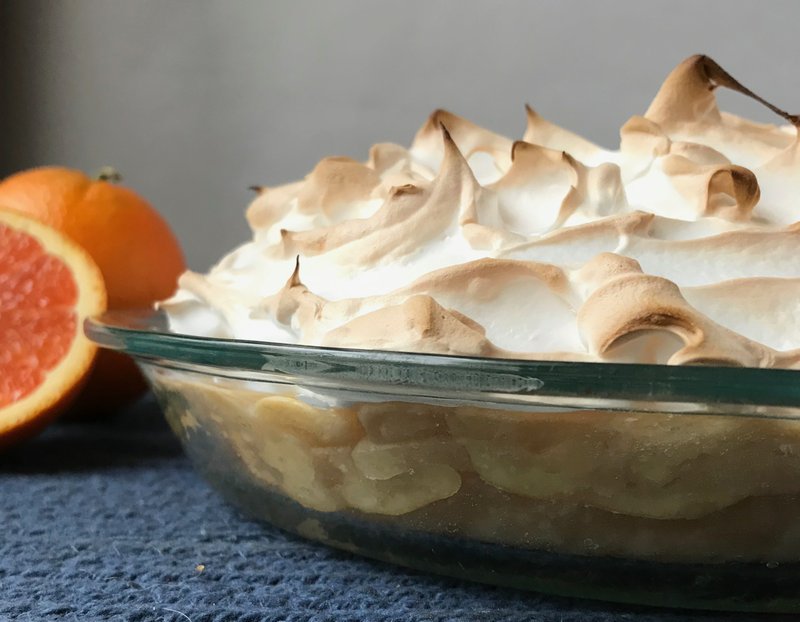I've been keeping an eye out at the supermarket for Cara Cara oranges. Last week I finally spotted a bag and knew it was time to share this recipe.
Originating in Cara Cara, Venezuela, in the 1970s, Cara Cara is a variety of navel orange. It differs from common navel oranges in that it is slightly less acidic and sweeter and has pinkish flesh. They are one of my favorite varieties of oranges.

Meyer lemons are another favorite. Though technically a lemon — at least by name — Meyer lemons originated in China and are believed to be a hybrid of a citron and a mandarin. They're sweeter than ordinary lemons and rich, with floral and spicy notes. The lemons get their English name from Frank Meyer, who introduced them to the United States in the early 20th century.
And when the two seasons overlap, which is right now, it's time to make Cara Meyer Curd and then make Cara Meyer Meringue Pie.
But even if you can't find Cara Cara oranges and Meyer lemons, you should still make this pie — just use ordinary lemons and navel oranges.
Cara Meyer Meringue Pie
1 cup Cara Cara orange juice
1 cup Meyer lemon juice
½ vanilla seedpod, split lengthwise (optional)
Finely grated zest from 1 orange or lemon
8 tablespoons butter, softened
½ to 1 cup granulated sugar, depending on sweetness of fruit
2 eggs PLUS 4 egg yolks (save whites for meringue)
Pinch of salt
1 (8- or 9-inch) prepared pie crust
For the meringue:
½ cup water
1 cup sugar
4 egg whites
Pinch table salt
½ teaspoon cream of tartar
½ teaspoon vanilla extract
In a small saucepan, bring the juices and vanilla seedpod to a boil over medium-high heat; reduce heat and simmer until juice is reduced to about 1 ½ cups.
Transfer the juice to a measuring cup to cool, and stir in the zest.
In a large glass or stainless-steel bowl, beat butter and sugar with an electric mixer until light and fluffy, about 2 minutes. Gradually add the eggs and yolks, one at a time, beating on low speed until well combined. Increase speed to medium and beat 1 minute. Beating on low speed, drizzle in the cooled juice. The mixture will look curdled, but don't worry, this is OK.
Add enough water to a medium saucepan to fill by 1 inch. Bring to a boil; reduce heat to a bare simmer. Place the bowl with the juice mixture over the simmering water. Whisking constantly, cook mixture until it is smooth and thick, about 15 minutes. The mixture is ready when it is thick enough to coat the back of a wooden spoon and running your finger through it leaves a trail.
Pour the curd into the prepared pie crust. You may have a little extra curd.
Adjust oven rack to middle position and heat oven to 400 degrees.
Combine water and sugar in small saucepan. Bring to a vigorous boil over medium-high heat. Once syrup comes to a rolling boil, cook 4 minutes (mixture will become slightly thickened and syrupy). Remove from heat and set aside while beating egg whites.
With electric mixer, beat whites in large bowl at medium-low speed until frothy, about 1 minute. Add salt and cream of tartar and beat, gradually increasing speed to medium-high, until whites hold soft peaks, about 2 minutes. With mixer running, slowly pour hot syrup into whites (avoid pouring syrup onto whisk or it will splash). Add vanilla and beat until meringue has cooled and becomes very thick and shiny, 5 to 9 minutes.
Using a rubber spatula, mound meringue over filling, making sure meringue touches edges of crust. Use the spatula to create peaks all over meringue. Bake until peaks turn golden brown, about 6 minutes. Transfer to wire rack and cool to room temperature.
Food on 02/05/2020

